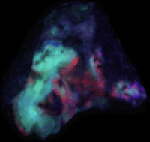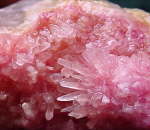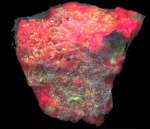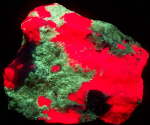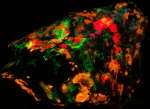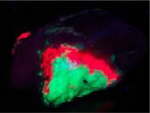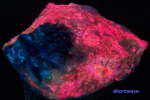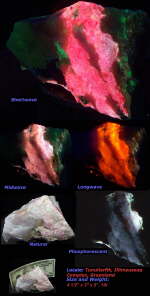| Tugtupite | |
| |
 Tugtupite
from the Kvanefjeld area is the most widely known fluorescent
mineral from Ilimaussaq. It is typically a bright gemmy red and
is the source for the gem material used in making beautiful tugtupite
cabochons. A typical piece of gem tugtupite will be found in an
analcime and lujavrite matrix, probably along with aegirine crystals.
The natural color ranges from a light pink to a deep cherry red.
Under shortwave the red glow is unmistakable. Commonly associated
(fluorescent) minerals include chkalovite, beryllite, and sorensenite.
Tugtupite
from the Kvanefjeld area is the most widely known fluorescent
mineral from Ilimaussaq. It is typically a bright gemmy red and
is the source for the gem material used in making beautiful tugtupite
cabochons. A typical piece of gem tugtupite will be found in an
analcime and lujavrite matrix, probably along with aegirine crystals.
The natural color ranges from a light pink to a deep cherry red.
Under shortwave the red glow is unmistakable. Commonly associated
(fluorescent) minerals include chkalovite, beryllite, and sorensenite.
 Taseq
Tugtupite – Found both in boulders that have rolled
to the bottom and in veins towards the top of the slopes, this
variety of tugtupite is quite different from that found on Kvanefjeld.
It was first found in the summer of 2002. It consists of a coarse
grained pink veining in massive crystals of analcime. Often
pieces are associated with aegirine (non FL) and what appears
to be a spotty green fluorescent analcime (or remnants of chkalovite).
Many pieces have vugs where micro crystals of tugtupite can be
found. Daylight color ranges from a light pink to deep pink,
but not yet found in a gemmy red state as on Kvanefjeld.
This material is also usually quite phosphorescent. It also usually
shows a significant color change under midwave UV light. View
a (large) animation of the three color states.
Taseq
Tugtupite – Found both in boulders that have rolled
to the bottom and in veins towards the top of the slopes, this
variety of tugtupite is quite different from that found on Kvanefjeld.
It was first found in the summer of 2002. It consists of a coarse
grained pink veining in massive crystals of analcime. Often
pieces are associated with aegirine (non FL) and what appears
to be a spotty green fluorescent analcime (or remnants of chkalovite).
Many pieces have vugs where micro crystals of tugtupite can be
found. Daylight color ranges from a light pink to deep pink,
but not yet found in a gemmy red state as on Kvanefjeld.
This material is also usually quite phosphorescent. It also usually
shows a significant color change under midwave UV light. View
a (large) animation of the three color states.
 Tugtupite
Crystals – The rarest fluorescent find to date was
made during the MinerShop 2002 Greenland “Geo-Adventure”.
One of the tour members found a boulder of tugtupite on the eastern
slopes. When he cracked it open he found a cavity of wonderfully
formed tugtupite crystals! Many pieces have micro crystals but
this piece was truly remarkable in size. Although not a
gemmy red, the tugtupite deepened in color to an intense pink.
A coating of what appears to be a uranyl activated green FL covered
many areas on the specimens, along with a yellowish glow –
perhaps from another associated (unknown) mineral. Exceedingly
rare, these are the only images
we know of on the web.
Tugtupite
Crystals – The rarest fluorescent find to date was
made during the MinerShop 2002 Greenland “Geo-Adventure”.
One of the tour members found a boulder of tugtupite on the eastern
slopes. When he cracked it open he found a cavity of wonderfully
formed tugtupite crystals! Many pieces have micro crystals but
this piece was truly remarkable in size. Although not a
gemmy red, the tugtupite deepened in color to an intense pink.
A coating of what appears to be a uranyl activated green FL covered
many areas on the specimens, along with a yellowish glow –
perhaps from another associated (unknown) mineral. Exceedingly
rare, these are the only images
we know of on the web.
 Blue
tugtupite from the Kvanefjeld area - There have been many
reports of “blue tugtupite” but no verifiable specimens.
A few pieces from the Kvanefjeld area show an unusual response
under MW ( and SW to a degree), glowing a medium intensity blue.
Only a couple of these specimens were found but these may account
for the rumors of blue tugtupite. The MW response of tugtupite
is unpredictable and can range from salmon -as under LW - to white.
The ones showing a white FL under MW are usually quite phosphorescent.
Blue
tugtupite from the Kvanefjeld area - There have been many
reports of “blue tugtupite” but no verifiable specimens.
A few pieces from the Kvanefjeld area show an unusual response
under MW ( and SW to a degree), glowing a medium intensity blue.
Only a couple of these specimens were found but these may account
for the rumors of blue tugtupite. The MW response of tugtupite
is unpredictable and can range from salmon -as under LW - to white.
The ones showing a white FL under MW are usually quite phosphorescent.
 Pink
FL Tugtupite - A very unusual variety of tugtupite can be
found on the Taseq Slopes. Unlike those found on Kvanefjeld, it
fluoresces a bright pink – not the typical cherry red. The
response under longwave is also quite remarkable – a bright
orange. The natural color is a deep (almost purple) red. In addition,
these specimens are dramatically phosphorescent a bluish white.
In many pieces tugtupite crystals are found which are clean
and well formed (micros). Also, polylithionite is commonly associated
with these specimens.
Pink
FL Tugtupite - A very unusual variety of tugtupite can be
found on the Taseq Slopes. Unlike those found on Kvanefjeld, it
fluoresces a bright pink – not the typical cherry red. The
response under longwave is also quite remarkable – a bright
orange. The natural color is a deep (almost purple) red. In addition,
these specimens are dramatically phosphorescent a bluish white.
In many pieces tugtupite crystals are found which are clean
and well formed (micros). Also, polylithionite is commonly associated
with these specimens.
 Tugtupite
enclosing Chkalovite - Exceptional specimens of chkalovite
(FL blue/green) being replaced by tugtupite have been observed
on the Taseq Slopes. These pieces are striking due to the
patterns, as well as the very interesting formation. The matrix
is analcime and lujavrite; the green FL is unknown but most likely
uranyl activated.
Tugtupite
enclosing Chkalovite - Exceptional specimens of chkalovite
(FL blue/green) being replaced by tugtupite have been observed
on the Taseq Slopes. These pieces are striking due to the
patterns, as well as the very interesting formation. The matrix
is analcime and lujavrite; the green FL is unknown but most likely
uranyl activated.
 “Tugtulite”
– Tugtup Agtakorfia is a small area right on the water in
the Tunulliarfik Fjord. It is the type locality for tugtupite
– discovered in 1962 by Sorensen. All of the pink/red tugtupite
has since been mined and all that was left in the vein were some
remarkable specimens of sodalite and this presently unknown mineral
(but thought to be a variety of tugtupite). This material
has three distinct color states under each wavelength - bright
peach under SW, bright white under MW, and bright orange under
LW. Additionally it is extremely phosphorescent a greenish white
- lasting for a very long time. EDS analysis reveals that the
peach FL mineral is “not a homogenous phase, but rather
a mixture of at least two and likely three different phases.”
Further research is being conducted on the makeup of this mineral
but for now we have given it the nickname “tugtulite”
for a combination of sodalite and tugtupite.
“Tugtulite”
– Tugtup Agtakorfia is a small area right on the water in
the Tunulliarfik Fjord. It is the type locality for tugtupite
– discovered in 1962 by Sorensen. All of the pink/red tugtupite
has since been mined and all that was left in the vein were some
remarkable specimens of sodalite and this presently unknown mineral
(but thought to be a variety of tugtupite). This material
has three distinct color states under each wavelength - bright
peach under SW, bright white under MW, and bright orange under
LW. Additionally it is extremely phosphorescent a greenish white
- lasting for a very long time. EDS analysis reveals that the
peach FL mineral is “not a homogenous phase, but rather
a mixture of at least two and likely three different phases.”
Further research is being conducted on the makeup of this mineral
but for now we have given it the nickname “tugtulite”
for a combination of sodalite and tugtupite.
 Tugtupite
and Polylithionite - Kangerlussaq yields dramatic specimens
of a white variety of tugtupite (appears to be albite under natural
light). When associated with small crystals of polylithionite
the brightness and depth of the red tugtupite is amazing.
Tugtupite
and Polylithionite - Kangerlussaq yields dramatic specimens
of a white variety of tugtupite (appears to be albite under natural
light). When associated with small crystals of polylithionite
the brightness and depth of the red tugtupite is amazing.
| Gallery of Tugtupite Images | ||||||||||||||||||||||||||||||||||||||||||||||||||||||||||||||||||||||||||||||||||||||||
|
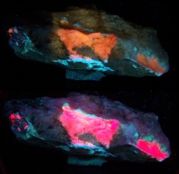
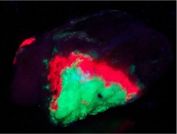 Chemical
formula: Na4AlBeSi4O12Cl. Hardness = 6.5, Density =
2.35
Chemical
formula: Na4AlBeSi4O12Cl. Hardness = 6.5, Density =
2.35